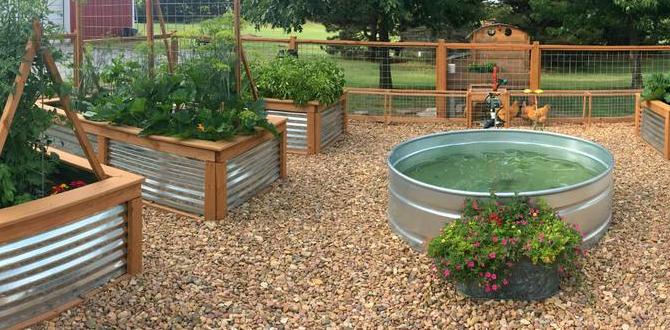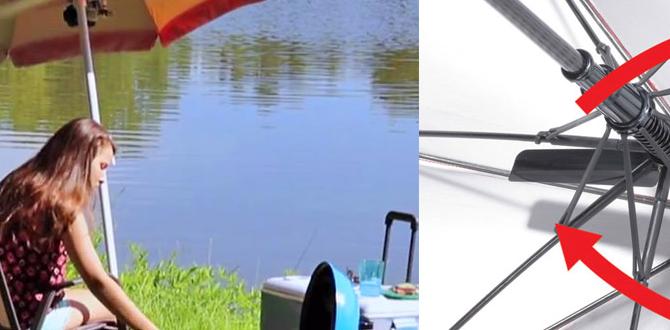Quick Summary:
A trellis for indoor plants is a support structure that helps climbing plants grow upwards and outwards, enhancing their beauty and health. It provides stability, directs growth, and can transform your plant display into a stunning green feature. This guide will show you how to choose, install, and care for the perfect trellis for your leafy friends.
Ever admired those lush, climbing plants gracefully scaling walls or winding around elegant structures? Want to achieve that stunning look with your own indoor greenery? You’re not alone! Many beginner plant parents find their vining plants sprawling out in less-than-ideal ways, taking up too much space and looking a bit wild. It can be a little frustrating when you know your plant has the potential for so much more. But don’t worry! With the right support, your indoor plants can reach their full, beautiful potential. This guide will walk you through everything you need to know about trellises for indoor plants, turning your plant dreams into a leafy reality. Get ready to see your plants flourish!
Why Your Indoor Plants Need a Trellis: More Than Just Support
Think of a trellis as a personal trainer and interior designer rolled into one for your climbing or vining plants. Without one, these plants might naturally trail downwards, get tangled, or spread out in a way that doesn’t showcase their best features. A trellis offers them a way to grow vertically, mimicking their natural growth habit in the wild where they’d climb trees or other surfaces. This isn’t just about looks, though. Proper support can lead to:
- Enhanced Air Circulation: When plants can spread out on a trellis, air moves more freely around their leaves. This helps prevent fungal diseases and keeps your plant healthier.
- Better Light Exposure: Vertical growth means more leaves have access to the light they need to photosynthesize, leading to more robust growth and vibrant foliage.
- Space Efficiency: Instead of letting plants sprawl across your furniture or floor, a trellis directs growth upwards, saving valuable space in your home.
- Aesthetic Appeal: Trellises can transform a simple pot and plant into a living work of art, adding a unique design element to your decor.
- Encourages Natural Growth: Many popular houseplants, like Pothos, Philodendrons, and Monsteras, are naturally vining plants. A trellis helps them fulfill their genetic destiny!
Choosing the Perfect Trellis for Your Indoor Plant Pal
Selecting the right trellis depends on a few things: your plant’s type and size, your aesthetic preferences, and your available space. Let’s break down the options so you can find the perfect match.
Types of Indoor Plant Trellises
The world of plant trellises is surprisingly diverse! Here are some popular choices for indoor gardening:
- Ladder Trellis: These are simple, vertical structures resembling a ladder. They’re great for plants that need a bit of vertical support but don’t necessarily have super-strong tendrils.
- Obelisk Trellis: These are tall, often pyramid-shaped or cylindrical structures. They provide ample support and can be quite decorative, acting as a focal point in your plant display.
- Fan Trellis: Shaped like a fan or half-circle, these are ideal for smaller pots or plants that need a wider area to spread out as they grow.
- Woven or Grid Trellis: Made from materials like metal, wood, or plastic, these often feature a grid pattern. This allows for flexible training of vines, as you can tuck stems through the openings.
- Sphagnum Moss Poles: While not a traditional trellis, these vertical poles covered in sphagnum moss are fantastic for climbing plants. The moss retains moisture, encouraging aerial roots to attach and grow, often resulting in larger leaf development for species like Monstera deliciosa and certain Philodendrons. You can buy these or easily make your own!
- DIY Options: Don’t underestimate the power of everyday items! Think about copper pipes, bamboo stakes arranged in a teepee, old embroidery hoops, or even a beautiful piece of driftwood. If it offers support and looks good, it can be a trellis.
Materials Matter: What to Look For
The material of your trellis can affect its durability, appearance, and how it interacts with your plant.
- Metal: Often durable and available in various styles. Look for rust-resistant options if your plant needs consistent humidity.
- Wood: Offers a natural, warm look. Ensure it’s treated or sealed if it will be exposed to frequent moisture to prevent rot. Cedar and redwood are good choices for their natural resistance to decay.
- Bamboo: Lightweight, sustainable, and affordable. It has a natural charm that complements many plant styles.
- Plastic/Resin: Lightweight, waterproof, and easy to clean. Can sometimes look less natural but is very practical.
- Coir/Fiber: Often used in moss poles, these are excellent for encouraging aerial root growth as plants climb.
Size and Scale: Finding the Right Fit
Consider the mature size of your plant and the pot it’s in. A tiny succulent might only need a small decorative piece, while a vigorous Pothos or Monstera will need a much larger, sturdier support. The trellis should extend significantly above the current height of the plant to encourage upward growth. Aim for a trellis that is at least half, and ideally equal to, the height of the plant it will support in its mature form, or plan to add extensions.
Simple Steps to Install Your Indoor Plant Trellis
Getting your trellis set up is usually straightforward. The key is to do it early in the plant’s growth or when repotting for minimal disturbance.
Step 1: Gather Your Tools (if needed)
Depending on your trellis type, you might need:
- Your chosen trellis
- Your plant
- Fresh potting soil (if repotting)
- Watering can
- Trowel (if repotting)
- Plant ties or garden twine (optional, for securing the plant)
Step 2: Choose the Right Time
The best time to install a trellis is:
- When you first bring a new vining plant home.
- When you’re repotting your plant into a larger container.
- During the plant’s active growing season (usually spring/summer).
This minimizes stress on the plant’s roots and allows it to establish itself with the trellis from the start.
Step 3: Install the Trellis
For pots with an existing plant:
- Gently loosen the soil around the edge of the pot, away from the main root ball.
- Carefully insert the base of the trellis into the soil. Aim to push it down as deep as possible for stability without damaging the roots. If the pot is very full, you might need to remove a small amount of soil first.
- Position it slightly off-center to give the plant room to grow.
For repotting:
- Gently remove your plant from its old pot.
- Loosen any tightly bound roots.
- Place the trellis in the center or slightly to one side of the new, larger pot.
- Add fresh potting soil around the plant and the trellis base, ensuring the trellis is firmly seated.
- Water thoroughly.
For decorative or standalone trellises: Some trellises are designed to stand on their own on a shelf or desk and may not need to be inserted into the pot. Others are built into the pot itself.
Step 4: Guide Your Plant
Once the trellis is in place, gently guide your plant’s stems towards it. If your plant has tendrils or aerial roots, they will naturally begin to attach themselves as they grow.
For plants that don’t have strong tendrils, you might need a little help initially:
- Use soft plant ties, strips of cloth, or garden twine to loosely secure the main stems to the trellis.
- Avoid tying too tightly, as this can constrict the stem and damage the plant. The goal is just to provide initial support until the plant can climb on its own.
Training Your Plant to Climb: The Art of Nurturing Growth
Training your plant to use its new trellis is a rewarding process. It requires a little patience and gentle guidance.
Encouraging Aerial Roots
Many vining houseplants have aerial roots – those little nubs that grow from the stems. These roots are designed to seek out surfaces to cling to. If you have a moss pole or a trellis with a textured surface, these aerial roots will be drawn to it.
- Misting: Regularly misting the aerial roots and the surface of the climbing support can encourage them to attach.
- Humidity: High humidity is crucial. If your home is dry, consider using a humidifier in the room or placing the pot on a pebble tray filled with water (ensure the bottom of the pot isn’t sitting directly in the water).
- Patience: Some plants are more eager climbers than others. Keep guiding new growth towards the trellis.
Securing the Stems
As your plant grows, you’ll want to help direct its new stems onto the trellis. Do this gently, especially with younger or more delicate stems.
- When a new vine starts to grow, carefully wrap it around the trellis or use a soft tie to attach it.
- If a stem is growing away from the trellis, gently redirect it. It might take a few days for the stem to adjust its direction.
- Don’t force stems into unnatural positions; rather, encourage them along the natural lines of the trellis.
Dealing with Leggy Growth
Sometimes, plants can become “leggy” – meaning they have long stems with sparse leaves. This can happen if the plant isn’t getting enough light or support. A trellis can help, but you might also consider pruning.
- Pruning: Pruning back leggy stems can encourage bushier growth and more leaves closer to the base of the plant. Simply cut a stem back to just above a node (where a leaf attaches to the stem). New growth will emerge from that node. Propagating the cuttings is a bonus!
- Light: Ensure your plant is receiving adequate light for its species. Insufficient light is a common cause of legginess.
Popular Plants That Love a Trellis
Not all indoor plants are natural climbers, but many popular varieties thrive with a little vertical encouragement. Here are a few examples:
| Plant Name | Trellis Type Recommendation | Growth Habit | Key Benefit of Trellis |
|---|---|---|---|
| Pothos (Epipremnum aureum) | Ladder, Grid, Moss Pole | Vining, trailing | Promotes larger leaf size and an upright display. |
| Philodendron (various vining types like P. hederaceum) | Ladder, Grid, Moss Pole | Vining, trailing | Encourages fuller growth and helps prevent bare spots. |
| Monstera (e.g., Monstera deliciosa) | Large Moss Pole, Sturdy Obelisk | Climbing, vining | Essential for mature plants to develop fenestrations (splits) in leaves. |
| Hoya (Wax Plant) | Fan, Ladder, Coil | Vining, cascading | Helps manage growth and can encourage blooming. |
| English Ivy (Hedera helix) | Grid, Ladder | Vining, climbing via aerial rootlets | Prevents an unruly appearance and supports healthy foliage. |
| Satin Pothos (Scindapsus pictus) | Small Ladder, Grid | Vining, trailing | Enhances the beautiful, silver-patterned leaves. |
| Grape Ivy (Cissus rhombifolia) | Ladder, Grid | Vining | Supports its structure and encourages lushness. |
Caring for Your Trellised Plants
Once your plant is happy on its trellis, a few specific care adjustments will help it truly shine.
Watering and Drainage
Trellises don’t drastically change watering needs, but keep in mind:
- Even Moisture: Aim for consistently moist (but not soggy) soil.
- Check Soil: Always check the top inch or two of soil before watering.
- Drainage is Key: Ensure your pot has drainage holes. Excess water needs to escape to prevent root rot. A trellised plant is still a potted plant!
For more on optimal watering practices, the University of Wisconsin-Madison Extension offers excellent, research-backed advice on watering houseplants.
Fertilizing
As your plant grows vigorously on its trellis, it will use up nutrients in the soil faster. Regular feeding can support this growth.
- Feed your plant with a balanced liquid houseplant fertilizer diluted to half strength during the growing season (spring and summer).
- Fertilize every 2-4 weeks, depending on the fertilizer instructions and your plant’s visible growth.
- Reduce or stop fertilizing in fall and winter when plant growth naturally slows down.
Pruning for Shape and Health
Occasional pruning is beneficial:
- Encourage Bushiness: Pinch back the tips of growing vines to encourage side shoots and a fuller plant.
- Manage Size: Trim back overly long or stray vines to maintain the desired shape and prevent the plant from becoming unwieldy.
- Remove Yellow/Dead Leaves: Keep the plant looking tidy and healthy by removing any unsightly foliage.
Repotting with a Trellis
When your plant outgrows its pot (roots are circling the bottom, or water drains very quickly), it’s time to repot. This is the perfect opportunity to upgrade your trellis if needed or ensure the existing one is still well-seated.
- Choose a pot that is 1-2 inches larger in diameter than the current one.
- Gently remove the plant and its trellis from the old pot.
- Add fresh potting mix to the new pot, position the plant and trellis, and fill in with soil.
- Water well.
Troubleshooting Common Trellis Issues
Even with the best intentions, you might encounter a few hiccups. Here’s how to handle them:
Plant Not Climbing
Problem: Your plant’s tendrils or aerial roots aren’t attaching.
Solution:
- Ensure the plant is healthy and actively growing. Lack of nutrients or light can stunt growth.
- Increase humidity around the plant and its aerial roots.
- Gently guide new growth towards the trellis and use soft ties to secure the stem initially.
- If using a moss pole, ensure it’s consistently moist.
Trellis Falling Over
Problem: The trellis is unstable in the pot.
Solution:
- Ensure the trellis base is inserted deep enough into the soil.
- If the pot is large enough, try moving the trellis to a different spot for better stability.
- Consider using a larger, heavier pot or a trellis with a wider base for very tall or heavy plants.
- For temporary fixes, you can sometimes prop it against the pot rim or the pot itself.
Stem Damage from Ties
Problem: Plant ties are constricting the stem as it grows.
Solution:
- Loosen or remove ties that are becoming tight.
- Use soft, flexible ties like fabric strips, old stockings, or specialized plant ties that allow for expansion.
- Only use ties to guide the plant initially; the goal is for the plant to eventually attach on its own.
Eco-Friendly Trellis Options and DIY Ideas
Gardening with a sustainable mindset is at the heart of EcoPatchy! Luckily, many trellis solutions can be eco-friendly and budget-friendly.
Upcycling and Repurposing
Look around your home for items that can be repurposed:
- Old Ladders: Small decorative ladders found at craft stores or flea markets can make charming plant supports.
- Metal Hangers: Bend wire




